Forts of Maharashtra - The Silent Sentinels of History and Culture!
Maharashtra can easily be described as the state of Forts - those silent sentinels of the bygone era, witnesses to the deeds of bravery and courage of thousands of men and women, each uprooted and broken stone within them speaking of the glory that was! Maharashtra is home to more than 350 forts dotted all over the state, the sheer number and diversity of their structure is totally amazing and mindboggling, because no other country or state in the world has so many forts! Right from ground forts on plain lands, water-locked sea forts to high mountain forts that are built on such dangerous and steep cliffs, the diversity is amazing. Many of the forts were built during the reigns of Bahamani, Rashtrakutas, Satvahanas and Shilaharas but almost all the forts are associated with Chhatrapati Shivaji Maharaj as he put his stamp on each of these forts. He also built many forts and established his rule in the Deccan region managing to hold the Mughals at bay for many years. All of these forts have held a place of great significance and importance in both the history and geography of Maharashtra. The remoteness and invincibility of the Sahyadri ranges lending further inaccessibility to these forts were the key factors which were well exploited by Chhatrapati Shivaji Maharaj in his guerilla warfare against the Mughals. This is the reason why all these forts have a special places in the hearts of all Maharashtrian people and treks to the various forts are akin to a pilgrimage of great religious importance.
There are hordes of people, especially young men and women who diligently make a trek to the forts almost every weekend, every winter and summer vacation. There are many professional groups too who organize treks to these forts. Visit to Maharashtra is considered incomplete if you fail to visit even a single fort. To understand Maharashtra, it is necessary to visit at least a few of the forts! There are examples of many people who have fallen in love with these forts and have dedicated their lives to reaserching and restoring these forts with great love and care.
Starting with Pune region, it can be considered as the Fort capital of Maharashtra as there are many forts in and around Pune district. When travelling from Pune towards any direction, you are bound to see at least one or two forts on the way.
Here are some of the best known forts:
Sinhagad Fort
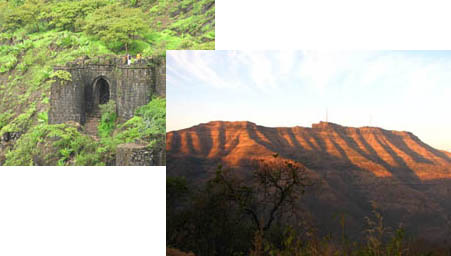 Previously known as Kondana, Sinhagad, literally meaning The Lion's Fort is the closest in location to Pune city, roughly around 30 kilometres towards the southwest. It is located in close proximity to Purandar, Torana and Rajgad forts and is located at the centre of these forts atop an isolated cliff of the Bhuleshwar range in the Sahyadri Mountains. Kondana, named after the rishi Kaundinya is believed to be built 2000 years ago and changed many hands until in 1647 young Shivaji gained control of it, passing again into the possession of the Mughals during the pact of 1649 with Adil Shah. From 1662 through 1665, the fort withstood many attacks from Mughals but remained invincible, but had to be handed over to Mirza Raje Jaisingh - a minister in the court of Aurangzeb. Again in 1670, Shivaji Maharaj's soldiers, famously called as 'mavales' after the Maval district, attacked the fort and regained control of it under the leadership of Tanaji Malusare, who fought like a lion and sacrificed his own life while getting the fort back. Shivaji Maharaj renamed Kondhana as Sinhagad in memory of Tanaji Malusare, quoting the famous words "Gad aala pan Sinha gela" which means that 'we gained the fort but lost our lion'. The fort has only two doors of entry, Pune Darwaza and Kalyan Darwaza.
Previously known as Kondana, Sinhagad, literally meaning The Lion's Fort is the closest in location to Pune city, roughly around 30 kilometres towards the southwest. It is located in close proximity to Purandar, Torana and Rajgad forts and is located at the centre of these forts atop an isolated cliff of the Bhuleshwar range in the Sahyadri Mountains. Kondana, named after the rishi Kaundinya is believed to be built 2000 years ago and changed many hands until in 1647 young Shivaji gained control of it, passing again into the possession of the Mughals during the pact of 1649 with Adil Shah. From 1662 through 1665, the fort withstood many attacks from Mughals but remained invincible, but had to be handed over to Mirza Raje Jaisingh - a minister in the court of Aurangzeb. Again in 1670, Shivaji Maharaj's soldiers, famously called as 'mavales' after the Maval district, attacked the fort and regained control of it under the leadership of Tanaji Malusare, who fought like a lion and sacrificed his own life while getting the fort back. Shivaji Maharaj renamed Kondhana as Sinhagad in memory of Tanaji Malusare, quoting the famous words "Gad aala pan Sinha gela" which means that 'we gained the fort but lost our lion'. The fort has only two doors of entry, Pune Darwaza and Kalyan Darwaza.
The bastions that were built at only strategic points are now mostly lying in ruins and the two main gates also were in pretty bad shape, but the pathways have now been restored to its functionality. There is a bungalow atop that was erected by the great freedom fighter Lokmanya Bal Gangadhar Tilak. The fort also has memorials for Tanaji Malusare and Rajaram, the younger son of Shvaji Maharaj.
Now the fort serves as training base for the cadets at the National Defence Academy, Khadakwasla, Pune. It is also a picnic spot for Puneites and for trekking enthusiasts.
Lohagad Fort
Lohagad is situated 25 kilometres from Pune and divides the basins of rivers Indrayani and Pavana, sitting atop a side range of the Sahyadris with 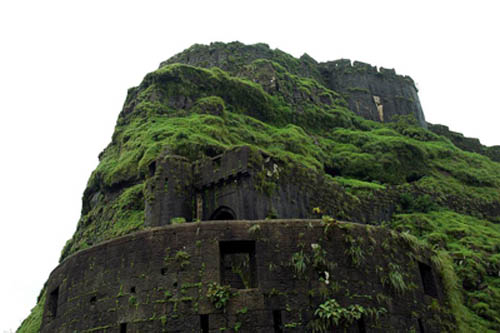 Visapur fort towards its Eastern side. Different dynasties have occupied this fort at different periods of time from Satvahanas, Chalukyas, Yadavas, Bahamanis, Rashtrakutas, Mughals and Marathas. Its most significant character is a natural long spur on the western side, which looks like a scorpion's tail, fortified from military point of view which is called as Vinchukata - vinchu meaning a scoprion and kata means a thorn.
Visapur fort towards its Eastern side. Different dynasties have occupied this fort at different periods of time from Satvahanas, Chalukyas, Yadavas, Bahamanis, Rashtrakutas, Mughals and Marathas. Its most significant character is a natural long spur on the western side, which looks like a scorpion's tail, fortified from military point of view which is called as Vinchukata - vinchu meaning a scoprion and kata means a thorn.
The fort is now a monsoon haven for trekkers and mountaineers and the climb is very invigorating. The view from the fort is splendidly breathtaking. During monsoons, the fort is literally under the cover of mists and clouds.
Close to the Lohagad fort is the Bhaja caves, one of the hundreds of Chaitya caves, carved by Buddhist monks, found all over Maharashtra.
Visapur Fort
Visapur is the bale-killa of Lohagad forts, which literally means its twin. There are many more such bale-killas built from strategic point of view during military maneuvers. Built by the first Peshwa - Balaji Vishwanath during 1713-1720, it is much younger than the Lohagad but of equal stature and importance. Because of its close proximity to Lohagad as both forts are on the same mountain range, when the British gained control over Visapur fort, they blew up its north and south gateways to make Lohagad even more inaccessible. The fort is therefore pretty much in ruins with nothing left intact inside, but the majority of the outer walls are still seen in good condition with two massive bastions that used to flank one of the main gateways.
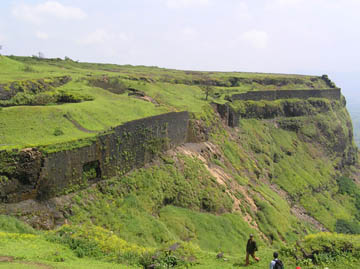
Torna Fort
Torna is also called as Prachandgad and is considered significantly important in the history of the Marathas as this was the first fort captured by Shivaji Maharaj in 1643, at a very young age of sixteen. Originally the fort is said to be built by the Shaiva panth or the followers of Lord Shiva in 13th century. After capturing the fort, Shivaji renamed it as Torna. It has become a favorite amongst the trekkers from Pune.
Rajgad
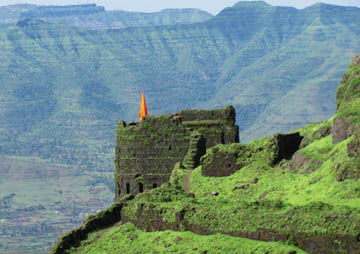
The fort is surrounded by three main sub-plateaus called as 'machee' namely, Sanjeevani(north), Padmavati (southwest) and Suvela (south east) and a central volcanic bale-killa. These machees and the bale-killa is the reason why Rajgad is invincible and unconquerable. Mughals unsuccessfully lead a siege around Rajgad for years. The fort's base is around 40 kilometres in diameter which is why many such sieges were unsuccessful.
The many ancient water tanks and the Padmavati lake on its summit provide water to the trekkers all years around.
Purandar Fort
Situated about 32 kilometres from Pune, the fort actually consists of two gads Purandar and Vajragad, also called as Rudramal. Purandar is believed to be built by the Yadavas in 11th century. The fort is well known in history for the valiant courage of Murarbaji Deshpande, Purandar's killedar or the keeper of the fort, who valiantly and obstinately fought against the Mughals to retain the fort. His death led to Shivaji Maharaj signing the Treaty of Purander in which he was allowed to keep only 12 forts and to surrender 22 other forts captured by him, to Aurangzeb. Another significant event attached to Purandar is the birth of Sambhaji Maharaj, Shivaji Maharaj's eldest son and successor.
Purandar was also used as a prison during the British rule for World War II prisoners and as a sanatorium for British soldiers. Remnants of British occupancy in the form of an abandoned church is seen now on the top.
The fort is now used as a base for trekkers and paragliders.
Pratapgad
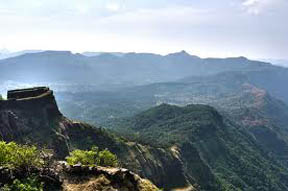 Situated near Mahabaleshwar, the fort is significant in Maratha history for the assassination of Afzal Khan by Shivaji Maharaj. The fort was built by Shivaji Maharaj's prime minister Moropant Trimbakji Pingale, commissioned by Shivaji Maharaj. The fort stands on densely forested Koyna river basin and was considered the strong hold of Maratha empire. The Shivaji-Afzal Khan episode also proved as a test of mettle for the Maratha army thus increasing their confidence and heralded the establishment of the empire. The characterstic feature of the fort is the double-layered fortification walls built around the fort with massive bastions at intervals. A statue of Shivaji Maharaj is constructed on the top which was unveiled by Pandit Nehru in 1959 to mark the tricentennary of the historical killing of Afzal Khan.
Situated near Mahabaleshwar, the fort is significant in Maratha history for the assassination of Afzal Khan by Shivaji Maharaj. The fort was built by Shivaji Maharaj's prime minister Moropant Trimbakji Pingale, commissioned by Shivaji Maharaj. The fort stands on densely forested Koyna river basin and was considered the strong hold of Maratha empire. The Shivaji-Afzal Khan episode also proved as a test of mettle for the Maratha army thus increasing their confidence and heralded the establishment of the empire. The characterstic feature of the fort is the double-layered fortification walls built around the fort with massive bastions at intervals. A statue of Shivaji Maharaj is constructed on the top which was unveiled by Pandit Nehru in 1959 to mark the tricentennary of the historical killing of Afzal Khan.
Raigad
Raigad became the capital of the Maratha empire in 1647 when Shivaji Maharaj became the crowned king. It is situated in Mahad, district Raigad. Built by Chandrarao More in 1030, most of the strutures lie in ruins now, after being bombed by the British 1818, who saw it as a threat to their rule. It features famous points such as the 'takmak tok' which was used as a point of execution - sentenced convicts were thrown to certain death from this steep cliff.
The bastion called 'hirkani buruj' was constructed after a young woman named 'Hirkani' from the village at the foothills famously climbed down the 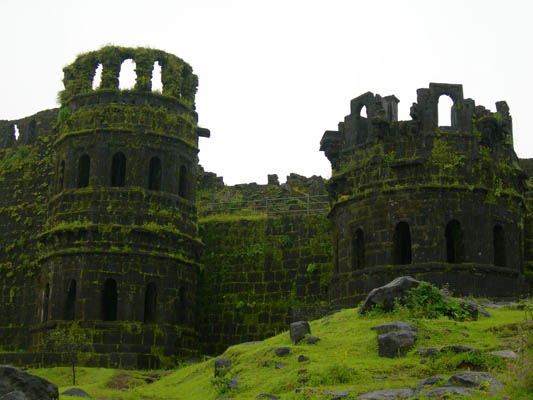 fort. The story goes that she used to come every morning in the fort to sell milk and go back home at sunset. One day she was late in reaching the gates and finding them locked at sunset. She pleaded the guards to unlock the gates but they refused to do so, out of respect for their duty and commitment and also fearing reprisal by Shivaji Maharaj himself. She had left her infant son home and was desperate to reach home, so she wandered around looking for a way down and at one point, she scrambled down through steep cliffs, thorns and dense bushes, in total darkness, and made her way home. The next day when she returned to the fort, the guards were completely taken aback and the news carried to Shivaji Maharaj who personally asked her account. She repeated her feat again in front of him and was rewarded by him amply, for her courage and bravery and also for showing him the breach that could easily happen in the fort's security. He then built the bastion from where she had climbed down and named it after her.
fort. The story goes that she used to come every morning in the fort to sell milk and go back home at sunset. One day she was late in reaching the gates and finding them locked at sunset. She pleaded the guards to unlock the gates but they refused to do so, out of respect for their duty and commitment and also fearing reprisal by Shivaji Maharaj himself. She had left her infant son home and was desperate to reach home, so she wandered around looking for a way down and at one point, she scrambled down through steep cliffs, thorns and dense bushes, in total darkness, and made her way home. The next day when she returned to the fort, the guards were completely taken aback and the news carried to Shivaji Maharaj who personally asked her account. She repeated her feat again in front of him and was rewarded by him amply, for her courage and bravery and also for showing him the breach that could easily happen in the fort's security. He then built the bastion from where she had climbed down and named it after her.
Now, the fort is a favorite destination for the history students, followers of Shivaji Maharaj and trekkers and mountaineers. There is also a ropeway that has been built now to reach the top.
Harishchandragad
This extremely beautiful and invincible fort is situated in the Ahmednagar district. This fort is very ancient in origins and has a mention in various puranas such as Skandapurana, Agnipurana, Matsyapurana etc. There are many caves found in the fort that contain idols belonging to Lord Vishnu. Although the exact period of its construction is not known, it is believed to be built in the medieval period since the temples of Harishchandreshwar and Kedareshwar indicate its relation to the Shaiva sect, and was captured by the Marathas in 1747.
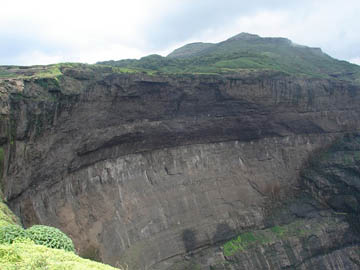
The fort features many interesting and spectacular features such as the Konkan Kada (kada means cliff). This is situated at the west and looks down upon the Konkan region, hence the name Konkan Kada. The view from this point is breathtakingly beautiful, especially during the sunset. This is the ultimate favorite destination of hardcore trekkers who normally start climbing the fort during the day time so as to reach this point just when the sun starts setting in the west. The colours that are seen during this time are amazing and the view is unforgettable. During the rains, the splendidness of the view multiplies at least by a hundred times.
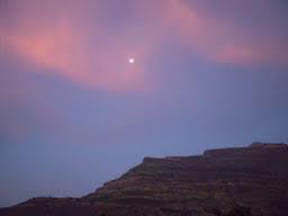
Other spots on the fort include Harishchandreshwar, Kedareshwar temples, Saptatirtha Pushkarni, Taramati peak etc. The various water tanks on the fort provide water all year round to the trekkers and visitors. Trekkers and mountaineers normally camp here at night in the various caves, which are looked after by the villagers. The villagers also provide food to the trekkers except during the monsoons.
Besides regular trekking and climbing, the fort is a paradise for avid rock climbers and rappellers.
Panhalgad or Panhala
This fort is in the Kolhapur district, situated overlooking the major trade route from Bijapur towards the coastal Maharashtra. Because of its proximity to Bijapur and strategic location, the fort was the centre of attraction and a cause for various conflicts between the Marathas, Mughals, the British Empire. The fort was built by the Shilahars during the early 12th century was an important bastion for the Bahamanis of Bidar province. Panhala is famously associated with the valiant Baji Prabhu Deshpande, who battled with the Mughals to hold them at bay so that Shivaji Maharaj could escape safely from Panhala and reach Vishalgad. This battle took place in a passage leading from Panhala, which is now called Pavan Khind, because it is here that Baji Prabhu battled with his life as blood fell from his injuries thus making the soil here sacred.
After Sambhaji fell from favours of his father Shivaji Maharaj, he was imprisoned on the fort, later on to escape his imprisonment.
Many of the structures and buildings are intact, the main ones being Sajja Kothi, Dharma Kothi, Teen Darwaja in addition to several small temples and mausoleums. A fully functional village is still situated on the fort and there are many good hotels to be found where one can stay quite comfortably. There are also a few schools, government offices etc. on the fort. Panhala is now a major hill station since the climate is very pleasant throughout the year.
Sindhudurg
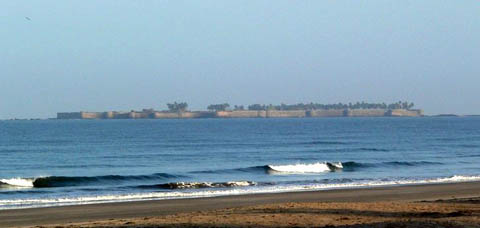
There are about 15 to 16 families who are permanent residents here, descendents of the original residents. The fort is a popular summer destination for Indian and foriegn tourists. It has now become a favorite destination for scuba diving and snorkelling.
Other Forts in Maharashtra
The forts that I have described above are only a few of the most significant ones. There are so many more remaining and it is a near-to-inmpossible task to describe them all in one article. Salher, the highest fort in Maharashtra in Nashik district with Mulher fortin its close proximity, Dhodap fort in the Satmala mountain range, Kulang fort situated at the borders of Ahmednagar, Nashik and Thane districts, with Alang and Malang in tow, Gorakshagad which is near murbad in Thane district, Ratangad near Bhandardara, Rajmachi near Pune, Alibag and Gharapuri near Mumbai, Murud-Janjira, Anjaneri in Konkan, Daulatabad or Devgiri near Aurangabad, Karnala fort in Raigad district, etc. etc....there are so many many more that need to be visited and their hsitory understood. Each and every single one of these is no less or no more important than the others. Each fort has had a great role to play in the history and has been instrumental in shaping the Maratha Kingdom and the Hindavi Swarajya, a beautiful dream that was seen and realized by the great warrior Chhatrapati Shivaji Maharaj. We can still feel the heart throbs of those valiant warriors who gave spilled their blood to realize this dream, if we carefully listen, we can hear their heart throbs. We only need to visit and feel the pulsating aura!
Forts in Literature
Many forts have found their way into popular literature giving rise to a genre called as 'Durg Sahitya'. Much of this literature has evolved around Shivaji Maharaj and portrays the lives and times of that era. Apart from that, the literature also is based on people who live on many of these forts, under extremely grueling conditions, disconnected from the modern world as we know. The mention of this genre is incomplete without the mention of Gopal Nilkanth Dandekar, fondly called as Gonida by his followers who spent his entire life living on many of the forts, especially Raigad, researching and documenting the life and work of Shivaji Maharaj. Another similar writer is Babasaheb Purandare, a historian and writer who mainly worked on the life of Shivaji Maharaj and is most famously known for the play 'Janata Raja' popular not only in India, but abroad as well.
Like it on Facebook, Tweet it or share this article on other bookmarking websites.

